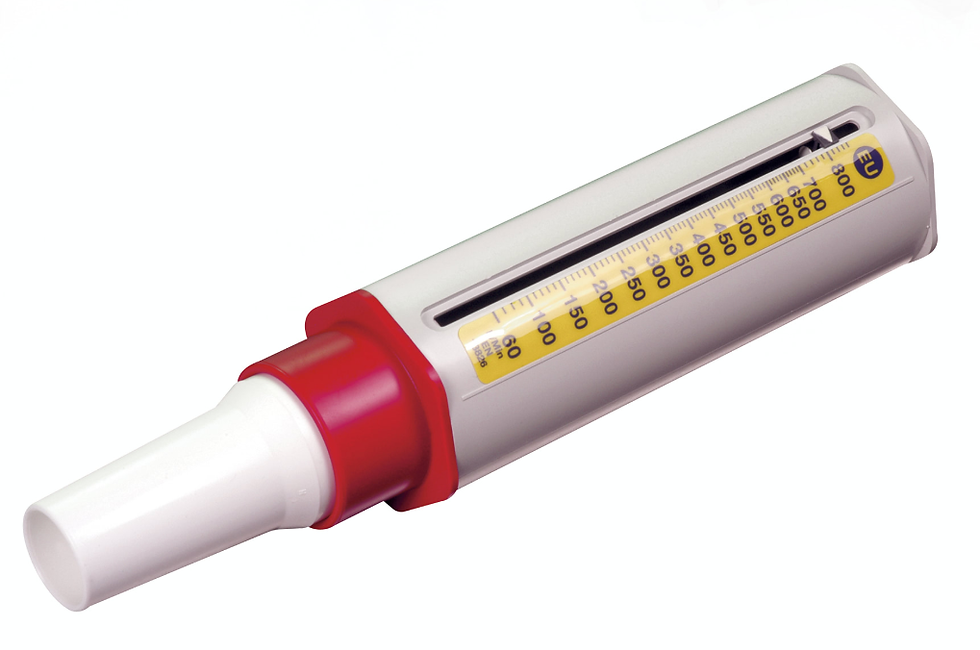How to Use a Peak Flow Meter at Home
- Gary Moller

- Aug 5, 2025
- 3 min read
And Why You Should

In this post-COVID era, with ongoing mRNA boosters and a surge in chronic health complaints, I’ve been seeing far too many cases of breathing difficulties — from nagging tightness in the chest to full-blown, life-threatening pneumonia. Lung infections of all kinds appear to be on the rise, and recovery is often slow and incomplete.
I've written previously about the mechanisms behind this worrying trend — including the role of cardiovascular insufficiency and something I refer to as the Venturi Effect. You can read that article here: The Venturi Effect: Cardiovascular Insufficiency and the Puzzle of Pneumonia
Lung diseases aren't being helped by the explosion of vaping, either — a habit that’s replacing cigarette smoking, yet may prove just as harmful, if not worse. Inhaling heated oils and synthetic substances deep into the lungs is, frankly, one of the daftest things a person could do for their health. And unlike fads that come and go, this one is being sustained. If people persist, so too will the damage.
But I digress.

Why Use a Peak Flow Meter?
If you're recovering from a lung infection or struggling with reduced breathing capacity, the peak flow meter is a brilliant home tool. Simple, cheap, and reliable, it helps track your lung function over time.
Peak flow measurements won’t fix anything overnight — nothing natural and lasting ever does. But used consistently, they provide clear feedback about whether your lungs are getting worse, holding steady, or improving with the right lifestyle, nutrition, and therapy support.
Here’s something you won’t hear often:After a bout of pneumonia, or even a bad flu, most people never fully recover lung function. Worse, it often continues to decline slowly — unnoticed — for years.
We can measure that decline.
But here’s the good news — we can also halt it, even reverse it, especially when caught early. That’s what we’re aiming for. Small, slow improvements in peak flow over months and years show that your lungs are healing. And that’s what really matters.
Let’s not forget: even in healthy people, lung function declines about 1% per year after the age of 30. So if you’re holding steady — or even gaining ground — you’re doing incredibly well.
Getting a Peak Flow Meter
If you're being treated for a lung condition by your doctor, ask for one — you may be given one free of charge. Otherwise, buy one from a chemist or online. They’re inexpensive and easy to use. No fancy gadgets required.
How to Use a Peak Flow Meter
Do this a few times a week. Same time of day. Ideally morning and evening.
Stand or sit up straight.Good posture gives your lungs room to expand.
Make sure the meter reads zero.Slide the indicator to the bottom of the scale.
Take a deep breath in.Fill your lungs completely.
Place the mouthpiece in your mouth.Seal your lips tightly around it.
Blow out as hard and fast as you can.A single, forceful puff – not a slow breath.
Write down the number.This is your peak flow reading.
Repeat two more times.Take the best of the three readings.
Track Your Progress
Use a simple notebook or chart.
Look for patterns and long-term trends.
Note any dips after illness or changes following new therapies.
I have a simple chart for recording your peak flow measurements. Drop me an email if you want a copy.
Over time, your peak flow readings will tell a story — one of decline, stability, or, hopefully, recovery.
If lung function is declining despite your best efforts, that’s a red flag — and time to reassess your plan. But if you’re inching your way upward, even slowly, you’re on the right track.
Let’s keep those lungs freeranging and full of life.








Comments